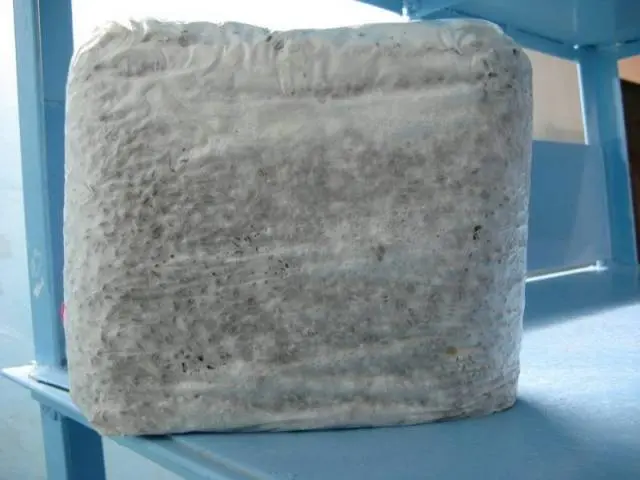Contents
Oyster mushrooms are a healthy and tasty product that is used to prepare various dishes. These mushrooms grow in forests in the middle lane, however, when a number of indicators are provided, they are also obtained at home. There are several ways to grow oyster mushrooms in the basement. The choice of the appropriate method depends on the size of the room and the availability of the necessary materials.
Features of oyster mushrooms
Oyster mushrooms are white or gray mushrooms that grow in separate groups on dead wood. The sizes of mushroom caps are 5-25 cm. When the necessary conditions are provided, the fruiting of the mycelium lasts for a year.
Oyster mushrooms contain protein, vitamins C and group B, calcium, iron and phosphorus. Their calorie content is 33 kcal per 100 g of product. Compared with champignons, they are considered more useful due to the rich composition.
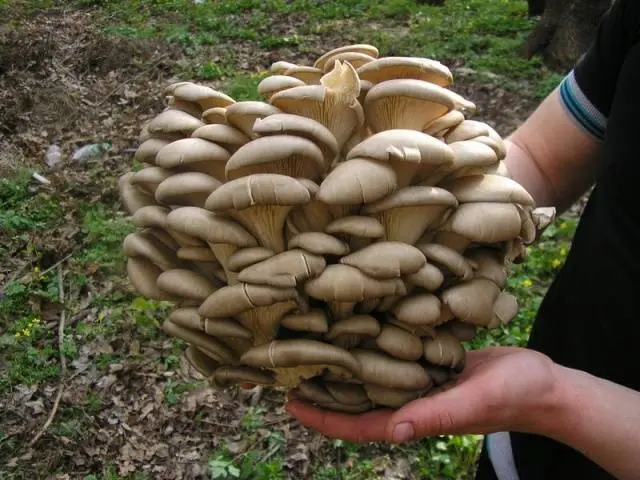
Eating oyster mushrooms improves immunity and suppresses cancer cells. They are also known for their antioxidant and antibacterial properties. These mushrooms are useful for anemia, high stomach acid and high blood pressure.
Oyster mushrooms should be used with caution, because in an increased amount they cause a hypersensitive reaction of the body.
Germination conditions
Oyster mushrooms grow under certain conditions:
- Constant temperature ranging from 17 to 28°C. Permissible temperature fluctuations are no more than 1-2°C. With more significant differences, the mycelium may die.

- Humidity over 50%. The optimal humidity for mushroom growth is 70-90%.
- Illumination. At a certain stage, the mycelium needs access to light. Therefore, in the basement you need to equip the lighting system.
- Ventilation.
Access to fresh air is provided by a ventilation system or by ventilating the basement.
Preparatory stage
A basement or cellar is suitable for growing oyster mushrooms. At the preparatory stage, mushroom mycelium and substrate are purchased or made independently. The premises must be prepared, disinfected and, if necessary, equipment installed.
Choice of growing method
In the basement, growing oyster mushrooms in the basement occurs in one of the following ways:
- in bags;
- on stumps;
- other improvised materials.

The most convenient growing method is the use of bags. It is best to choose strong plastic bags 40×60 cm or 50×100 cm in size. Bags with mushrooms are laid in rows or on racks, they are hung in a small room.
Under natural conditions, oyster mushrooms germinate on stumps. In the basement, mushrooms sprout on not too old wood. If the stump is dry, then first it is soaked for a week in a bucket of water.
You can also place the substrate in a plastic bottle with a volume of 5 liters or more or other suitable container.
Getting mycelium
Planting material for growing mushrooms is mycelium. It can be purchased at enterprises that breed oyster mushrooms on an industrial scale. Such companies obtain mycelium from spores in the laboratory.

If you have pieces of oyster mushrooms, you can get mycelium yourself. First, they are disinfected by treatment in hydrogen peroxide. Then the fungus is placed above the flame in a test tube containing a nutrient medium (oatmeal or potato agar).
Mycelium is stored for 2-3 weeks in a dark basement at a temperature of 24 ° C, after which you can start planting it.
The following varieties of oyster mushrooms can be grown in the basement:
- ordinary (grows naturally on stumps, has white flesh);
- pink (characterized by rapid growth and thermophilicity);
- oyster (a valuable type of mushroom with a pulp of lilac, blue or brown hue);
- strains NK-35, 420, K-12, P-20, etc. (such mushrooms are obtained artificially and are characterized by high yields).
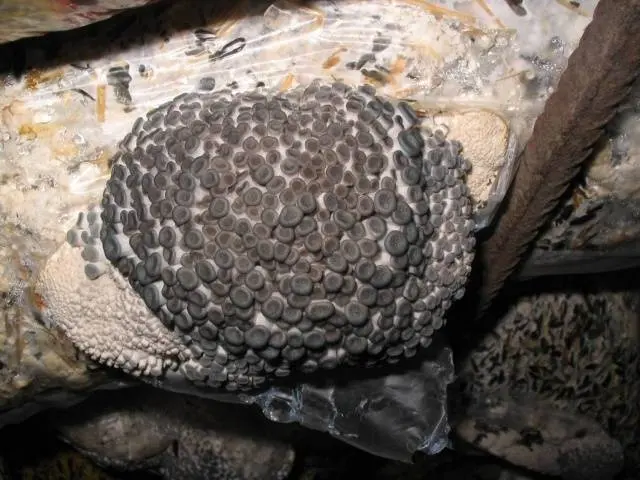
Substrate Preparation
Oyster mushrooms germinate on a substrate that is purchased ready-made or made independently. The following materials act as a substrate for mushrooms:
- barley or wheat straw;
- sunflower husk;
- crushed corn stalks and cobs;
- sawdust.
The substrate is crushed into fractions no larger than 5 cm. Then the base is disinfected to avoid the spread of mold and harmful microorganisms:
- The crushed materials are placed in a metal container and filled with water in a ratio of 1:2.
- The mass is put on fire and boiled for 2 hours.
- The water is drained, and the substrate is cooled and squeezed.
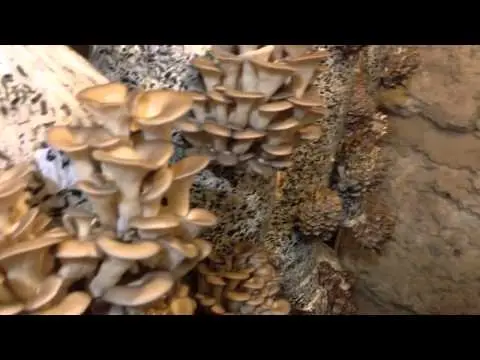
Basement arrangement
For breeding oyster mushrooms, it is necessary to prepare a basement. This room must meet the following requirements:
- the ability to maintain the required temperature;
- stable indicators of humidity;
- disinfection of all surfaces;
- the presence of light sources;
- ventilation.
Before planting oyster mushrooms in the basement, a number of preparatory work is carried out:
- the floor of the room must be concreted to reduce the likelihood of mold spreading on mushrooms;
- walls and ceiling should be whitewashed with lime;
- immediately before growing mushrooms, the room is sprayed with bleach and left for 2 days;
- after processing, the room is ventilated for several days.
To grow mushrooms in the basement and maintain a constant temperature, it is recommended to install a heater. If necessary, increase the humidity by spraying the walls and floor with water.
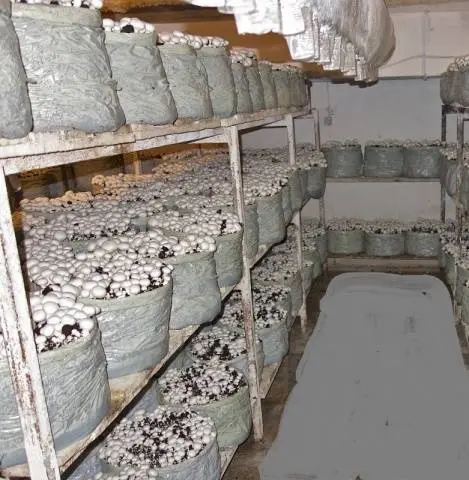
Lighting is provided by daylight fluorescent fixtures. 40 W lamps are installed on each block.
Growing order
The growing process includes three main steps. First, mushroom blocks are formed, which contain the substrate and mycelium. Then oyster mushrooms go through the stages of incubation and active fruiting. At each of these stages, the necessary conditions are provided.
Formation of mushroom blocks
The first step in the process of how to grow mushrooms is the formation of blocks. Mushroom blocks are a kind of beds on which oyster mushrooms sprout. When planting in bags, they are sequentially filled with substrate and mycelium. In this case, the top and bottom layers are the substrate.

Small slits are made in the prepared bags every 10 cm, through which the mushrooms will sprout. If plastic bottles are used, then oyster mushrooms are planted in the same way. Holes must be made in the container.
To get a good harvest on the stumps, you first need to make holes in them 6 cm deep and 10 cm in diameter. Then the mushroom mycelium is placed there and the stump is covered with a sawn wooden disk. The stumps are covered with foil and left in the basement.
Incubation period
During the first 10-14 days, mycelium grows. During the incubation period, the necessary growing conditions are provided:
- temperature 20-24°C, but not more than 28°C;
- humidity 90-95;
- lack of additional ventilation, which contributes to the accumulation of carbon dioxide;
- lack of lighting.

On the second day, white spots form on the substrate, which indicates the development of mycelium. At the end of the incubation period, the mushroom block becomes white. Within 5 days, the conditions necessary for the further growth of oyster mushrooms are provided.
Period of active growth
Active fruiting begins under the following conditions:
- temperature 17-20°C;
- humidity 85-90%;
- illumination of the order of 100 lx / sq. m. within 12 hours.
Be sure to ensure air circulation, which will eliminate excess carbon dioxide. When growing oyster mushrooms in bags, additional incisions are made to allow the germination of mushrooms.
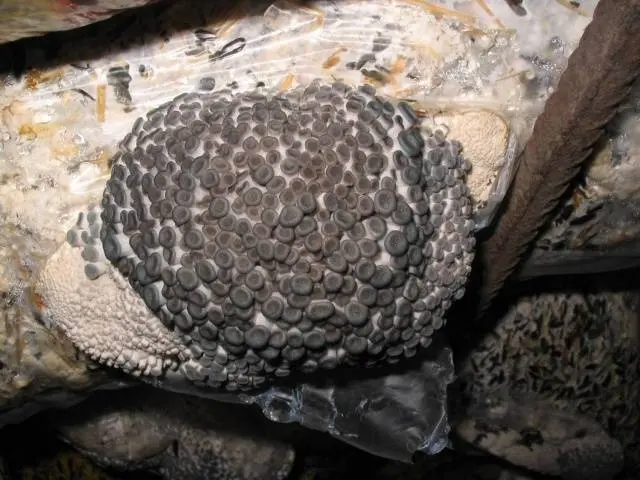
Harvesting
The first harvest of oyster mushrooms is harvested a month and a half after planting. Mushrooms are carefully cut at the base so as not to damage the caps and the mushroom picker. To extend their shelf life, oyster mushrooms are removed at once by the whole family.
The second wave of fruiting begins a week after the first harvest. During this period, 70% less mushrooms are harvested compared to the first wave. After a few more days, the mushrooms germinate again, but the yield of the block is significantly reduced.
Oyster mushrooms are stored in the refrigerator, where they are placed immediately after cutting. Mushrooms are not recommended to be soaked, it is enough to wash them under running water. Fresh oyster mushrooms keep in the refrigerator for 5 days.
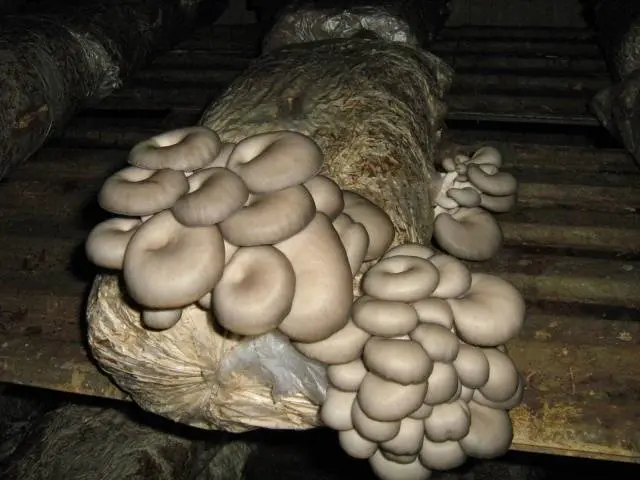
Mushrooms can be placed in plastic containers or wrapped in paper. Then the shelf life is extended to 3 weeks.
Frozen oyster mushrooms are stored for 10 months. For storage in this way, mushrooms do not need to be washed, it is enough to remove dirt with a piece of cloth.
Conclusion
Growing oyster mushrooms can become one of your hobbies or a profitable business. These mushrooms are rich in nutrients and, when used in moderation, have a positive effect on human health.
Oyster mushrooms are grown in the basement, which must be carefully prepared. To get a good harvest, it is necessary to provide a number of indicators: temperature, humidity and light.










